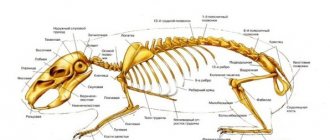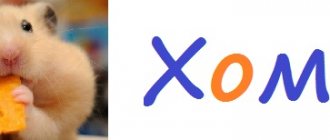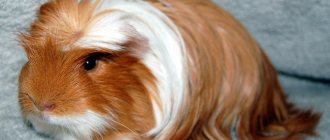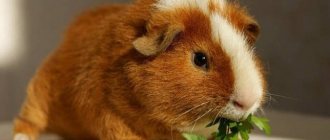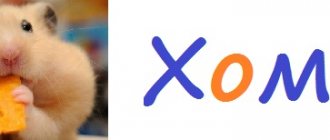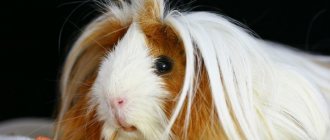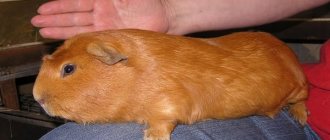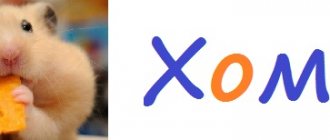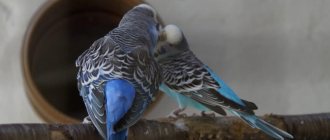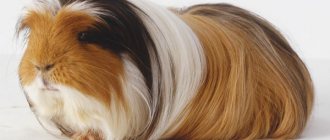- home
- Guinea pig
- Guinea pig breeds
02/06/2019 Among the representatives of such a popular animal as the guinea pig, there are more than 20 varieties. The alpaca breed has a special appearance that makes you want to touch the fur of this animal. From this article you will learn about this rodent.
Appearance
The alpaca breed is quite large. The male can reach a length of up to 20 centimeters with a weight of 800 grams, however, you can also find record holders whose weight reaches up to a kilogram. Female rodents are much smaller and can reach a maximum of only 650 grams of weight and 17 centimeters in body length.
The body of the pig is well developed, elastic and short. Shoulders set high. Usually the animal's muzzle is round and wide. The ears are large and drooping. The eyes are very large and expressive. The rodent has four toes on its front paws and three on its hind paws. The breed differs from others in the fur on its paws, which grows upward from the toes.
Features of wool
The main reason for the popularity of this type of pig is its special fur. Its length can reach 12 centimeters, however, this is not the limit. When it reaches a certain length, the fur begins to curl, forming curls that many owners like so much. After some time, bangs grow on the head and sideburns on the cheeks. This creates the appearance of a funny and cute animal. The wool itself resembles sheep.
Alpaca has a certain range of colors in its fur. There are black and white, red, two and three colors, and even Himalayan colors. To participate in exhibitions, the fur of this animal must be well-groomed and lie flat on the body.
Longhair
Shaggy breeds have thick, long fur and are in great demand among lovers of fluffy decorative rodents. They were bred artificially and subjected to strict selective selection.
Breeds whose standard officially includes a pure white color include the Peruvian (Angora) and Abyssinian guinea pig, Merino, Sheltie, Coronet, Texel and alpaca.
Abyssinian
This is the most interesting and most recognizable breed. The Abyssinian guinea pig has one very striking distinctive feature that immediately sets it apart from other varieties.
The Abyssinian coat must have so-called rosettes. They are a kind of funnels and appeared as a result of a genetic mutation.
Each Abyssinian guinea pig has about 6-10 rosettes on its body. They are located throughout the body and are absent only on the head and belly of the animal. Occasionally, the Abyssinian guinea pig has so-called “double rosettes.”
Their maximum number can reach 30 pieces. The animal's long fur can be painted in almost any color, including white.
Alpaca
Alpaca guinea pigs are covered with long, curly hair, the structure of which is more reminiscent of sheep's fleece. It grows from the tail to the head and forms a pair of rosettes on the rump and one on the crown. Representatives of the alpaca breed have coarser hair on their faces.
The color of the animals can be almost any color, including white. Occasionally among alpaca guinea pigs there are two- or three-colored individuals.
Coronet
The Coronet guinea pig has very long hair that flows down the sides and does not cover the face. There is a single rosette on the animal's head.
The coronet guinea pig comes in a variety of colors. It can be either monochromatic or combined. It is noteworthy that the white coronet is not very popular among breeders. It is believed that outwardly it loses to its brighter brothers.
Texel
The Texel cavy is covered with curly hair, the length of which reaches 15 cm. It grows from the head to the back of the body and cascades down the back.
The Texel guinea pig can have almost any color. Among the representatives of the breed there are even white individuals.
Merino
The breed was created by crossing a Coronet and a Texel. It has a crown-shaped rosette on its head and long, wavy fur that is white, gray or other colors.
Sheltie
The Sheltie guinea pig has long hair that does not flow along the sides, but simply falls back. More dense hair grows on the animal’s head, creating a kind of mane.
The Sheltie can have almost any color. But the white representative of this breed attracts less attention than his colored counterparts.
Peruvian
The Peruvian pig is also called the Angora pig. She has an aristocratic appearance and beautiful fur. There are rosettes on the nose and sacrum. The animal's muzzle is covered with long bangs. The Peruvian pig, or angora, weighs up to 1.5 kg and lives up to 6 years. It is painted in almost any color, including white.
Most often, Peruvian guinea pigs have silver-gray fur. Solid white color is extremely rare in the breed. Therefore, such caves are highly valued by breeders.
The long, soft coat of Angora Cavies grows straight forward. She needs careful care. Peruvian guinea pigs need to be brushed and trimmed regularly. And white animals can occasionally be washed with special shampoos for rodents.
Terms of content
The rich wool of the Alpaca breed obliges the owner to provide it with attention and care. It is necessary to teach the rodent to brush itself daily. In pet stores you can purchase special brushes that can be used to make your pig look more well-groomed. This brush will also help get rid of dead hairs so that they do not bother the animal.
It is not advisable to wash the pig, as water can wash away the protective covering on the animal’s body, which can cause it to catch a cold. It is better to use a damp cloth for this, but not more than once a week.
Some talk about the difficulty of caring for the coat of this breed, but there are advantages - due to the curly nature, average debris cannot get through the coat. Therefore, the fur accumulates much less debris.
You should protect your rodent from walking in the cold and overheating in the sun, but do not forget about fresh air. The optimal temperature would be 22 degrees away from bright light and drafts.
The alpaca guinea pig loves silence, so children in the apartment will disturb the rodent’s tranquility and also spoil the mood.
In what conditions should it be kept?
Alpaca is a calm and trusting animal. It is vital for him to communicate with his relatives, for which he needs to have them in pairs. The best choice is same-sex animals.
The guinea pig needs movement and satisfaction of natural curiosity. Constantly keeping an alpaca in a cage without the opportunity to walk and communicate with other pigs will give rise to psychological problems and can cause aggression.
To keep one pair of alpacas, you need to purchase a cage with a length of at least 120 cm and a width of at least 60 cm. The cage door should be located so that the animal can be conveniently taken out, and he can return to it on his own. The dune and the aquarium are not suitable for keeping guinea pigs due to insufficient thermoregulation and ventilation.
Necessary accessories for arranging the cage:
1.Bedding.
It must be remembered that pigs have very delicate skin on their feet and any rough filler is not suitable for the top layer. The bottom layer is absorbent: a layer of non-coniferous wood pellets or corn filler is placed in the tray. The top layer is a soft bedding like a bath mat.
2. Sennik.
The most convenient option is a hay barn located on the outside of the cage. The dried grass is pulled out by the animal as needed and always remains clean.
3. Drinking bowl.
For clean and fresh water, a heavy ceramic drinker or an automatic mounted one is suitable. The latter option is more convenient for the owner than for the animal, and requires more thorough cleaning.
Feeder
The feeder should be heavy ceramic to prevent it from tipping over.
House.
The best material for making a shelter is natural wood. In the house it is necessary to make several holes for entry from different sides.
If desired, you can make a low continuous floor in a cage, a hanging hammock, a wide tunnel and a bridge. A wheel for a guinea pig will be unnecessary, and lattice stairs and floors will be dangerous.
Branches for grinding teeth.
Any thick branches collected from nature will do.
Health and diet
Alpacas, like all guinea pigs, are in poor health. This breed is prone to allergies, colds, and bone fractures. Owners must carefully monitor the animals, otherwise a fall even from a low height, for example, from a table, can significantly affect the health of the rodent, even death.
Alpacas are prone to hair loss and allergies to poor diet. If you notice such a reaction, you should immediately change your diet and diet.
Due to its thickness, the fur is sometimes infested with mites and lice. To prevent the appearance of pests, treat the fur from time to time with special preparations that can be purchased at a veterinary pharmacy. If there is any strange behavior or symptoms, take your pig to the vet immediately.
This breed is an active animal; provide it with a large amount of food to replenish the energy spent on activities. It is recommended to feed them grass, lettuce and cabbage. You can also add fruits to your diet. It is also possible to find special food for these animals, which contains vitamins and minerals. This diet has a positive effect on the condition of the fur. But still, such nutrition is recommended for pregnant, old and lactating animals. There are no strict requirements for the number of meals consumed per day. The main thing is to maintain the amount of fresh food for the rodent.
The alpaca breed, like all other pigs, does not tolerate heavy pollution, so you need to regularly monitor the cleanliness of the cage and change the bedding.
Distribution of guinea pigs in Europe
During the years of the conquest of South America, the conquistadors gradually moved deeper into the continent and, naturally, encountered rodents weighing 1.0-1.5 kg in Indian villages and also ate them. Before setting off on the return voyage to Europe, pens were made on ships, and the herbivorous guinea pigs became a constant supply of fresh meat. True, some of the uneaten specimens ended up like unusual exotic pets in the homes of wealthy Europeans. Cute little animals quickly became fashionable among noble ladies and they began to be imported specifically for sale, and later bred in suitable conditions in the countryside. So they quickly spread throughout European countries, and then came to Russia.
Guinea pigs have become favorite decorative animals for children and adults around the world, and breeders have continued selection in other more aesthetic directions. If, as a result of painstaking work, a more curly or miniature guinea pig appeared, the price for it increased sharply, which is why today many selective ornamental breeds are sold all over the planet and the selection work continues.
Nowadays, guinea pig breeds are divided into groups, which include:
- short-haired, with a subspecies of smooth-haired;
- long-haired;
- wire-haired;
- without wool and with a small amount of wool.
A more detailed description of the guinea pig breeds in each group is further divided and each of them has its own leaders in popularity among amateurs and professional sellers.
Representatives of the short-haired group are the easiest to adopt at the initial stage of becoming interested in guinea pigs.
Below are just the most popular guinea pig breeds among pet lovers.
Owner reviews
Alpaca owners agree that these animals are smart creatures. They even communicate with each other using some sounds. Pigs remember the name given by the owner, and then respond to it. Owners can train their pets to eat at regular intervals.
The alpaca guinea pig is affectionate towards its owner and gets to know him well. The animal has a calm and peaceful disposition.
The owners note that this animal has one peculiarity: it likes to “talk,” also at night, usually for about 17–18 minutes. The sound resembles a whistle. This feature goes away over time, because pigs quickly adapt to new conditions.
Choosing and arranging a home
For a Peruvian guinea pig, you need to purchase a spacious cage, terrarium or enclosure.
All equipment must be durable and reliable so that food does not spill or water spills. In a spacious cage, you can equip a separate toilet, because pigs like to go to one place. This simplifies the cleaning that needs to be done daily.
It is best to place the cage in well-lit areas.
Keeping animals in a dark corner of the room has an adverse effect on the health and behavior of the rodent, so breeders are urged to place the cage near a window. However, in this case, drafts, which are destructive for Peruvians, should be carefully avoided.
It is very important that the place to sleep is comfortable. It is not recommended to buy houses, because pigs can hide there and become unsociable
It is better to choose a hammock or tunnel made of soft material.
